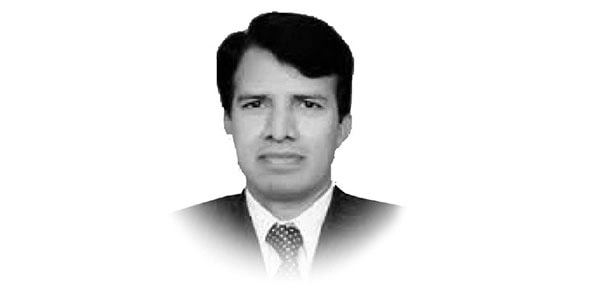Dilemma of Middle Eastern politics
IT was a rare drone attack, claimed by Houthis of Yemen at Abu Dhabi International Airport on January 17, 2022 which killed at least three people.
Until this attack on UAE, most of the Houthis’ attacks were centred against Saudi Arabia, since Riyadh has 1307 kilometres long border with Yemen; from Red Sea coast in the west to the Tripoint with Oman in the east.
Besides, there is a history of confrontation between Yemen and Saudi Kingdom.This attack is being viewed as a huge shift in the Houthis’ previous strategy of attacking only a limited space.
The pattern of this attack indicates that, Houthis are expanding their attacks beyond Saudi areas to broader GCC region.This strategy may gradually involve all regional states of GCC into a broader conflict zone.
Nevertheless, there is an implicit aspect of this attack, which is not debated anywhere at all since media is under strict control of those who wanted this aspect to remain hidden.
The hidden aspects of this drone attack can be rationally inferred, based its aftermaths which will have serious regional implications.
Indeed, the Houthis drone attack immediately provoked United States to send its military assistance to UAE.
Corollary to this attack, on February 12, 2022, United States sent its F-22A Raptor planes at Al Dhafra Air Base in the United Arab Emirates where there were 2000 U.S troops already stationed at the time of attack.
These U.S troops remained unhurt as a result of Houthis drone attack, which means attack, was not aimed to kill U.S troops but to craft an excuse to call for U.S reinforcement in UAE.
It is pointed out that, no US combatant or even any US national has ever been killed by Houthis or even Daesh (ISIS) in the Middle Eastern region.
Had it been the issue of response, the 2000 combatants of United States were sufficient to counter this drone attack.
This is in the perspective that, US military ensure security of its troops deployed anywhere by all means; aerial, surveillance system, counter attacks, neutralization of missile attacks and deactivation of drone and aerial attacks or the ground offensive.
It is worth mentioning that, after Houthis attack, US forces in UAE launched Patriot interceptor missiles for the first time after such missiles were fired against Iraq in 2003, once U.S invaded Iraq.
The exact number of F-22s moved into UAE and the number of airmen supporting the aircraft is still not known, however it is a major development from the perspective of regional security and expansion of US influence in the broader Middle East.
Reviewing the regional happenings of past one decade, it is evident that, U.S is in a hurry to move its maximum troops in the Middle East.
The ground realities are that; Middle Eastern region is engaged into a series of endless conflicts.
Starting from intra-state clashes, existent and persistent in almost all states of the region, there are numerous inter-state conflicts, resulted into larger regional instability.
The regional instability and inter-state conflicts provide pretexts to external forces which consequently involved in the regional politics of Middle East on the invitation of regional states.
As experienced in the past, upon their involvement in the regional politics of the Middle Eastern region, these external forces enlarge their sphere of influence, suiting to their own strategic and economic usages.
This is precisely being accomplished by United States for a broader controlover the Middle East before it’s peers (China and Russia) shrink the space for it (US).
It is evident from the statement of Lieutenant General Greg Guillot, the commander of American Air Force (Mideast Command).
He said, “The Raptors (F-22A Raptor planes)’ presence will bolster already strong partner nation defenses and puts destabilizing forces on notice that the U.S.and our partners are committed to enabling peace and stability in the region.
” Thisin fact is the consolidation of US military presence in the key states of the Middle Eastern region.
This ill-fated fate of Middle Eastern region has its beginning from world war-I and continuing till-date without any diminution from foreign involvement.
Until late 1960s, Britain and France kept a strong control over the regional politics as colonial powers.
They split the vast Arab landmass into smaller states for compounded reasons like; a) creating a Jewish homeland (State of Israel), b) crafting un-natural states to initiate future conflicts among them, c) to keep these crafted states security wise depended on west, and d) to manipulate the region as per the strategic usages of West as being done contemporarily.
This strategic crafting of region into various vested Middle Eastern states suited United States, once it directly involved into the regional politics in 1970s.
Though US direct involvement in the regional politics of Middle East is considered from 1970s as the security guarantor to the State of Israeli, the indirect role of Washington can be traced from WW-I and even in the crafting of existing Middle Eastern states.
Despite Russian endeavours to militarily deter US in the region and Chinese efforts to economically engage the Middle East, Washington seems to continue as the sole dictating power for a foreseeable future.
Indeed, US manipulates and run the regional politics of Middle East which include management of regional economies as per its strategic usages.
In summary, it can be conveniently said that, in the Middle East, ‘it is United States versus United States’.
— The writer is Professor of Politics and IR at International Islamic University, Islamabad.










